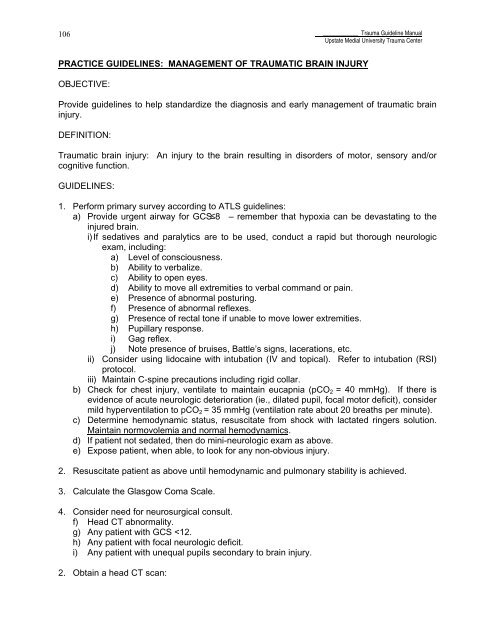Trauma Guideline Manual - SUNY Upstate Medical University
Trauma Guideline Manual - SUNY Upstate Medical University
Trauma Guideline Manual - SUNY Upstate Medical University
You also want an ePaper? Increase the reach of your titles
YUMPU automatically turns print PDFs into web optimized ePapers that Google loves.
106____________ <strong>Trauma</strong> <strong>Guideline</strong> <strong>Manual</strong><strong>Upstate</strong> Medial <strong>University</strong> <strong>Trauma</strong> CenterPRACTICE GUIDELINES: MANAGEMENT OF TRAUMATIC BRAIN INJURYOBJECTIVE:Provide guidelines to help standardize the diagnosis and early management of traumatic braininjury.DEFINITION:<strong>Trauma</strong>tic brain injury: An injury to the brain resulting in disorders of motor, sensory and/orcognitive function.GUIDELINES:1. Perform primary survey according to ATLS guidelines:a) Provide urgent airway for GCS ≤8 – remember that hypoxia can be devastating to theinjured brain.i) If sedatives and paralytics are to be used, conduct a rapid but thorough neurologicexam, including:a) Level of consciousness.b) Ability to verbalize.c) Ability to open eyes.d) Ability to move all extremities to verbal command or pain.e) Presence of abnormal posturing.f) Presence of abnormal reflexes.g) Presence of rectal tone if unable to move lower extremities.h) Pupillary response.i) Gag reflex.j) Note presence of bruises, Battle’s signs, lacerations, etc.ii) Consider using lidocaine with intubation (IV and topical). Refer to intubation (RSI)protocol.iii) Maintain C-spine precautions including rigid collar.b) Check for chest injury, ventilate to maintain eucapnia (pCO 2 = 40 mmHg). If there isevidence of acute neurologic deterioration (ie., dilated pupil, focal motor deficit), considermild hyperventilation to pCO 2 = 35 mmHg (ventilation rate about 20 breaths per minute).c) Determine hemodynamic status, resuscitate from shock with lactated ringers solution.Maintain normovolemia and normal hemodynamics.d) If patient not sedated, then do mini-neurologic exam as above.e) Expose patient, when able, to look for any non-obvious injury.2. Resuscitate patient as above until hemodynamic and pulmonary stability is achieved.3. Calculate the Glasgow Coma Scale.4. Consider need for neurosurgical consult.f) Head CT abnormality.g) Any patient with GCS
















